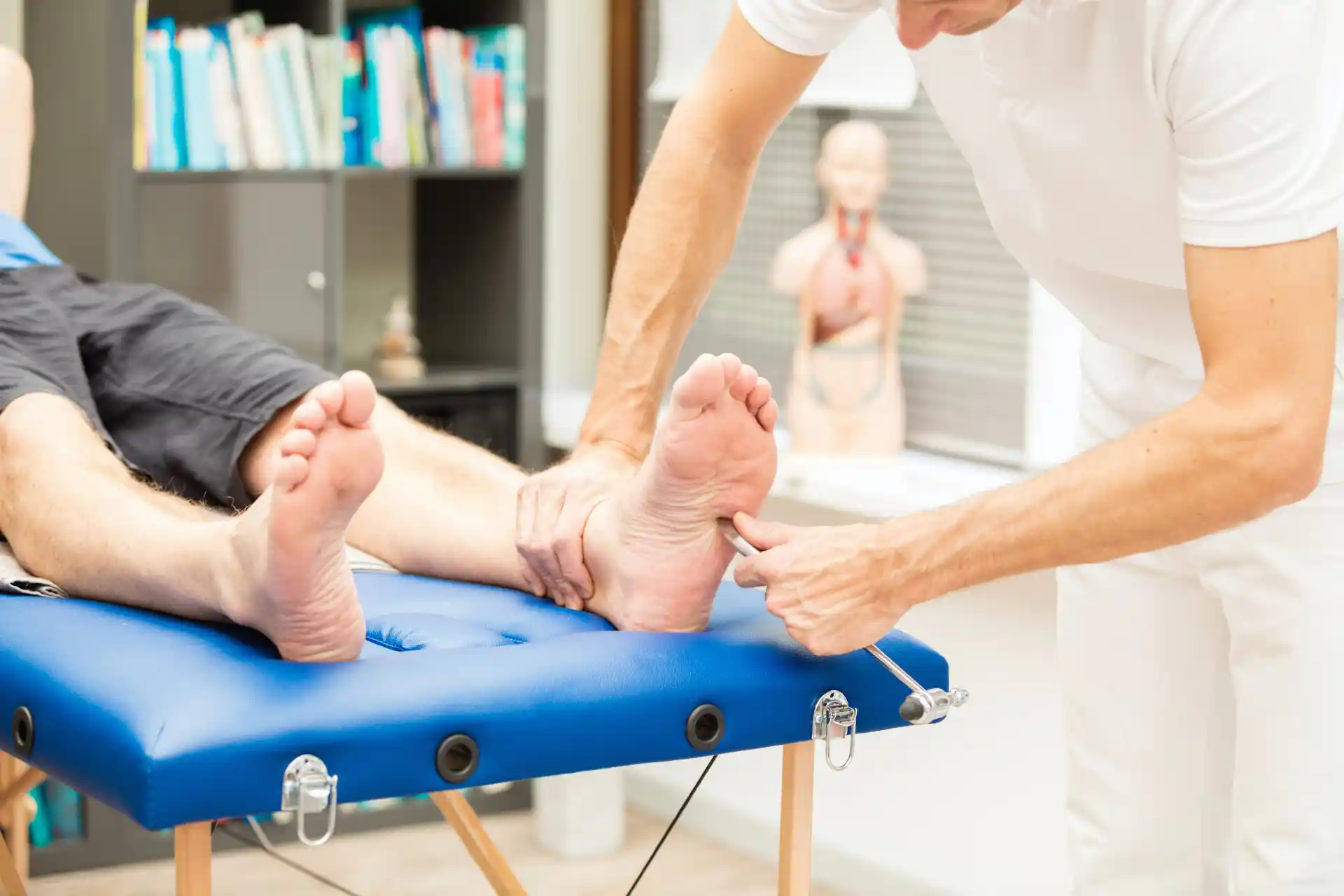Understanding Lateral Collateral Ligament (LCL) Injuries
When it comes to ligament injuries, the lateral collateral ligament (LCL) is a commonly affected structure. Understanding the LCL and recognizing the causes and symptoms of LCL injuries is essential for proper diagnosis and treatment.
What is the Lateral Collateral Ligament?
The lateral collateral ligament (LCL), also known as the fibular collateral ligament, is a band of tissue located on the outer side of the knee joint. It connects the femur (thighbone) to the fibula (the smaller bone in the lower leg). The LCL plays a crucial role in providing stability to the knee joint, particularly in preventing excessive sideways movement of the knee.
Causes and Symptoms of LCL Injuries
LCL injuries often occur due to direct trauma or excessive force applied to the inner side of the knee joint. Some common causes of LCL injuries include:
- Sports Injuries: LCL injuries are frequently seen in sports that involve sudden changes in direction, such as football, soccer, and skiing. A forceful impact or a sudden twisting motion can strain or tear the LCL.
- Traumatic Accidents: Car accidents or falls that involve a strong impact on the outer side of the knee can also result in LCL injuries.
The symptoms of an LCL injury may vary depending on the severity of the injury but commonly include:
- Pain on the outer side of the knee
- Swelling and tenderness
- Instability or feeling of looseness in the knee joint
- Difficulty bearing weight on the affected leg
- Limited range of motion
It's important to note that LCL injuries can sometimes occur simultaneously with other knee injuries, such as ACL tears or MCL tears. If you suspect an LCL injury, it's crucial to seek medical evaluation and diagnosis to determine the extent of the injury and receive appropriate treatment.
To learn more about diagnosing and treating LCL injuries, continue reading the next section on "Diagnosis and Treatment Options."
Diagnosis and Treatment Options
When it comes to a lateral collateral ligament (LCL) injury, accurate diagnosis and appropriate treatment are key to a successful recovery. In this section, we will explore the medical evaluation and diagnosis process, as well as the treatment strategies commonly used for LCL injuries.
Medical Evaluation and Diagnosis
To determine if you have a lateral collateral ligament injury, a medical evaluation is necessary. During this evaluation, your healthcare professional will assess your symptoms, conduct a physical examination, and may order diagnostic tests to confirm the diagnosis.
During the physical examination, your doctor will assess the stability of your knee joint and check for signs of tenderness, swelling, or bruising along the LCL. They may also perform specific tests, such as the varus stress test, to evaluate the integrity of the LCL. Diagnostic tests, such as X-rays or MRI scans, may be ordered to visualize the extent of the injury and rule out any associated damage to other structures in the knee.
Treatment Strategies for LCL Injuries
The treatment approach for LCL injuries depends on the severity of the injury and the individual's specific circumstances. In general, treatment options for LCL injuries include both non-surgical and surgical approaches.
Non-Surgical Treatment:
- Immobilization: For mild LCL injuries, your doctor may recommend immobilizing the knee using a brace or a cast to allow the ligament to heal.
- Physical Therapy: Physical therapy plays a crucial role in the non-surgical treatment of LCL injuries. Your physical therapist will guide you through exercises that focus on strengthening the surrounding muscles, improving balance and stability, and gradually restoring the range of motion in your knee. They may also incorporate other modalities, such as ultrasound or electrical stimulation, to aid in the healing process.
- Pain Management: Over-the-counter pain medications or prescribed pain medications may be used to manage pain and reduce inflammation during the healing process.
Surgical Treatment:
- In cases where the LCL is severely damaged or other structures in the knee are affected, surgery may be recommended. Surgical options for LCL injuries may include ligament repair or reconstruction, depending on the extent of the damage and the individual's specific needs. Your orthopedic surgeon will discuss the surgical procedure in detail and provide guidance on the rehabilitation process following the surgery.
It's important to note that the treatment approach will be individualized based on factors such as the severity of the injury, the individual's activity level, overall health, and personal goals. Your healthcare professional will work closely with you to develop a treatment plan that suits your specific needs and maximizes the chances of a successful recovery.
In the next section, we will delve into the importance of rehabilitation and the specific exercises and therapies that can aid in the healing process of LCL injuries. Stay tuned for more information on how to regain strength and stability in your knee.
Rehabilitation and Recovery
When it comes to recovering from a lateral collateral ligament (LCL) injury, rehabilitation plays a crucial role in restoring strength, stability, and function to the affected knee. Following a comprehensive rehabilitation program can help you regain mobility, reduce pain, and prevent future injuries. Let's explore the importance of rehabilitation and some exercises and therapies that can aid in the healing process.
Importance of Rehabilitation
Rehabilitation is essential for a successful recovery from an LCL injury. It helps in restoring strength, flexibility, and range of motion to the knee joint. A structured rehabilitation program designed by a healthcare professional, such as a physical therapist, will focus on specific exercises and therapies to target the injured ligament and surrounding structures.
Rehabilitation aims to:
- Reduce pain and inflammation in the knee.
- Restore normal knee joint range of motion.
- Strengthen the muscles around the knee to provide stability.
- Improve balance and coordination.
- Enhance proprioception, which is your body's awareness of its position in space.
- Gradually reintroduce functional activities and sports-specific movements.
By following a personalized rehabilitation plan, you can optimize your recovery and minimize the risk of reinjury. It's important to note that rehabilitation timelines can vary depending on the severity of the injury and individual factors. Patience and consistency are essential for a successful rehabilitation journey.
Seek RELIEF®
The RELIEF® procedure is a scientifically-backed approach designed to address the underlying issues of ligament injuries, by specifically targeting damaged fascia surrounding the area of injury and discomfort. The treatment combines ultrasound guidance and hydrodissection techniques to help release fascial adhesions, reduce inflammation, and promote scar tissue healing, in order to help free a potentially compromised ligament and address injury symptoms.1,2,3
To learn how RELIEF® can help manage your ligament injury symptoms, without the need for steroids, medication, surgery, anesthesia, or post-procedure immobilization, contact us today to schedule a consultation.
Exercises and Therapies for LCL Healing
During the rehabilitation process for an LCL injury, your healthcare professional may recommend specific exercises and therapies to promote healing and strengthen the knee. Let's explore some common exercises and therapies that are often part of a comprehensive rehabilitation program:
Range of Motion Exercises
These exercises focus on gradually restoring the normal range of motion in your knee joint. They may include:
- Ankle pumps and circles
- Heel slides
- Quadriceps sets
- Hamstring stretches
- Calf stretches
Strengthening Exercises
Strengthening exercises target the muscles around the knee to provide stability and support. Examples of exercises that may be included are:
- Straight leg raises
- Wall squats
- Step-ups
- Hamstring curls
- Calf raises
Balance and Proprioception Exercises
These exercises help improve balance and proprioception, which are crucial for joint stability and injury prevention. Some common balance and proprioception exercises include:
- Single-leg stance
- Balance board exercises
- Bosu ball exercises
- Proprioception drills
Manual Therapy
Manual therapy techniques, performed by a skilled physical therapist, can help reduce pain, improve joint mobility, and enhance tissue healing. These techniques may include:
- Soft tissue mobilization
- Joint mobilization
- Manual stretching
Modalities
Modalities such as heat or cold therapy, ultrasound, and electrical stimulation may be used as adjuncts to help manage pain, reduce inflammation, and promote healing.
Remember, it's important to consult with a healthcare professional before starting any exercise or therapy program for your LCL injury. They will tailor the program to your specific needs and monitor your progress along the way.
By diligently following your rehabilitation program, you can optimize your recovery from an LCL injury and regain the strength and function of your knee. Stay committed, be patient, and always seek guidance from healthcare professionals to ensure a safe and effective rehabilitation journey.
Preventing Future LCL Injuries
After experiencing the challenges of a lateral collateral ligament (LCL) injury, it's natural to want to take steps to prevent any future injuries. By implementing injury prevention strategies and practicing long-term care and maintenance, you can significantly reduce the risk of re-injuring your LCL.
Injury Prevention Strategies
- Proper Warm-up and Stretching: Before engaging in any physical activity or exercise, it's crucial to warm up your muscles and perform dynamic stretches. This helps increase blood flow to the muscles and prepares them for the upcoming activity.
- Strengthening Exercises: Focus on strengthening the muscles surrounding the knee, especially the quadriceps and hamstrings. Strong muscles provide better stability and support to the knee joint, reducing the likelihood of LCL injuries. Consult with a physical therapist or trainer to develop a targeted strengthening program.
- Proper Technique and Form: Whether you're participating in sports or performing everyday activities, maintain proper technique and form. This ensures that your body is aligned correctly and reduces unnecessary stress on the ligaments.
- Wear Protective Gear: When engaging in high-impact activities or sports, wearing appropriate protective gear can help minimize the risk of injuries. This may include knee braces, padding, or supportive footwear.
- Gradual Progression: Avoid pushing yourself too hard or too quickly when starting a new exercise or training regimen. Gradually increase the intensity and duration to allow your body to adapt and reduce the risk of overuse injuries.
Long-Term Care and Maintenance
- Maintain a Healthy Weight: Excess weight puts additional stress on your joints, including the knee. Maintaining a healthy weight can help reduce the load on your LCL and decrease the risk of injury.
- Cross-Training: Engage in a variety of physical activities and exercises to promote overall strength, flexibility, and balance. Cross-training helps prevent muscle imbalances and reduces the strain on specific ligaments.
- Listen to Your Body: Pay attention to any signs of discomfort or pain during physical activities. If you experience pain or swelling in your knee or any other joint, take a break and give your body time to rest and recover.
- Regular Check-ups: Schedule regular check-ups with your healthcare provider or orthopedic specialist. They can assess your joint health, provide guidance on injury prevention, and address any concerns you may have.
By incorporating these injury prevention strategies and maintaining long-term care and maintenance, you can significantly reduce the risk of future LCL injuries. Remember to always consult with healthcare professionals for personalized advice based on your specific situation.
To learn how RELIEF® can help manage your ligament injury symptoms and accelerate your injury recovery, contact us today to schedule a consultation.
.jpg)
.jpg)




.svg)